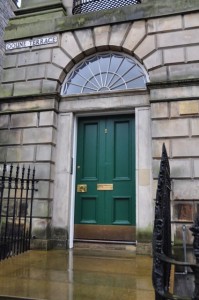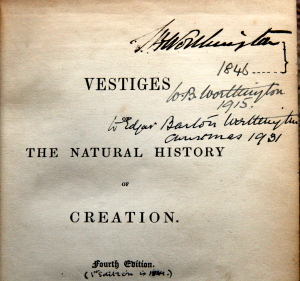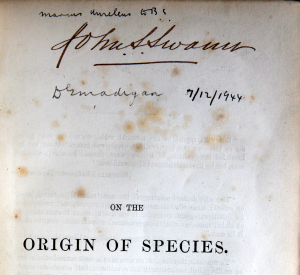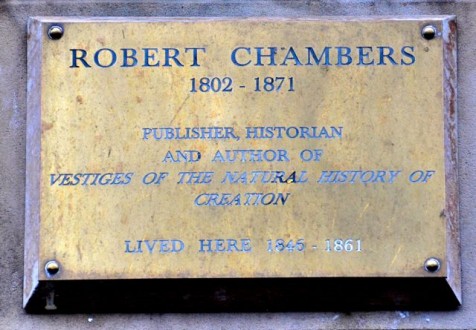This post is for anyone who has ever looked through an old book and wondered who its previous owners were.
The intrigue starts with the discovery of a name inside the front cover, or an elegant family bookplate, or perhaps some obscure ephemera tucked in amongst the pages. These kinds of evidence, along with the book’s theme, content, and price, can tell a lot about the previous owner – who may turn out to be more interesting than the book itself. Once the purview of bibliofiles and librarians, provenance research is now accessible to anyone; in a Google world we can all be book detectives.
Science books are no exception, as I discovered with three of my own. The books are connected in so far as they either paved the way for, or hammered home, the idea of evolution in the Victorian mind.

The ‘Vestiges of the Natural History of Creation‘, anonomously authored by Robert Chambers and first published in 1844 was, in its day, no less than pocket poison – the shocking scarlet cover and atheist inferences destined to become James Secord‘s “Victorian Sensation“. Then – ‘Explanations‘ – Chamber’s unapologetic sequel; published a year later in response to a torrent of criticism and dismay. And, last but not least, Charles Darwin’s iconical work ‘on the Origin of Species‘, first published in 1859.
Mid-nineteenth century editions such as these would have been expensive items, objects of desire for the professional or aspiring man of business. These sort of people were often successful in their own right and, along with their descendents, are likely to have left their mark on the world. To the owners…….

The first page of this Vestiges tells us the book has spent at least three generations with the Worthington family. The first custodian ‘J.H.’ was probably the first owner of this 1845 fouth edition. The book passed next to ‘W.B.’ in 1915, and finally to Edgar Barton Worthington as a christmas gift in 1931. Based on one evening’s Googling, the clearest picture emerges around the last owner – E.B.W. As is doubtless common knowledge to those who share the subject’s profession and have a knowledge of its history, Dr Edgar Barton Worthington was a biologist and zoologist. A fellow of the Royal Geographical Society, EBW worked extensively in Africa to become the Nile expert, was a personal friend of paleoanthropologist Mary Leakey (of human ancestor artifact fame), and corresponded with Liddell Hart. From 1962, he managed the 10 year International Biological Programme (IBP), the first attempt to manage rationally the world’s reserves in the face of a changing environment and rising population – sounds familiar. The death of EBW in 2001, aged 96, signaled the end of 150 years of Worthington custodianship for this Vestiges. Further research on W.B. and J.H. will have to wait for another evening.

The most likely candidate owner of Explanations is the chemist Thomas William Keates. Thomas William lived at Chatham Place in Blackfriars, London, and was elected as a Fellow of the Royal Chemical Society in 1852. He may not have set the sky on fire, but he did develop an improved method for turpentine distillation.

When the Origin of Species was published in 1859, the 37 year old John S Swann was working as a lawyer in Charleston, West Virginia. When the fourth edition was printed in 1866, Swann purchased his own copy – this one.
While Darwin was working up revised editions of the Origin of Species in the gentle surroundings of Downe in Kent, Swann was languishing in a Civil War prison. Indeed, one of Captain Swann’s two claims to fame is his survival, and later documentation, of his incarceration at Fort Delaware. Swann’s second notable achievement is the geological survey and topographical map he made of the Kanawha Coalfields in West Virginia; the first of its kind and work he pursued post-civil war – his legal career killed by his Confederate past. (Ironically, Kanawha county was embroiled in a modern day book banning controversy in 1974.)
I have no record of how or when Swann obtained his Origin. But, if it was bought on publication, two years after his release, it is likely the book was with him the twenty years he spent cogitating and planning his war memoirs – a period of introspection and hesitation reminiscent of Darwin’s own.
Happy researching.
